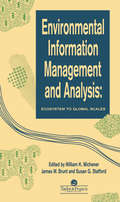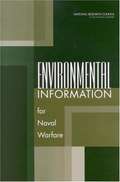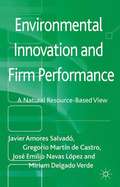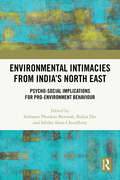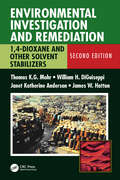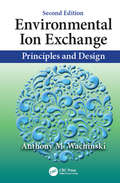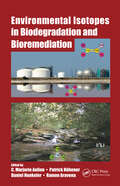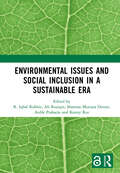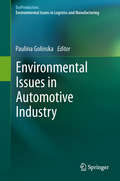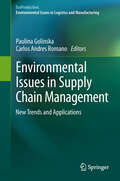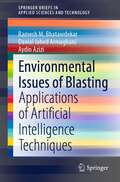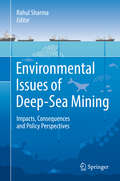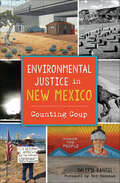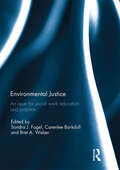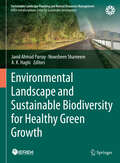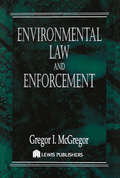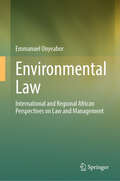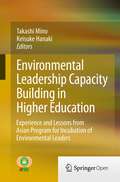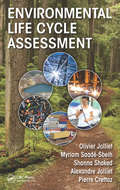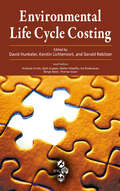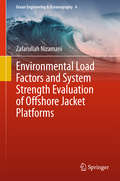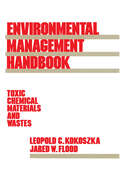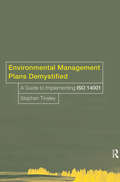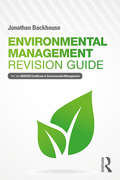- Table View
- List View
Environmental Information Management And Analysis: Ecosystem To Global Scales
by William K. Michener James W. Brunt Susan G. StaffordMost environmental studies are based upon data collected at fine spatial scales plots, sediments, cores, etc.. Furthermore, temporal scales of these studies have been relatively short days, weeks, months and few studies have exceeded three years duration the typical funding cycle.; Despite this history, environmental scientists are now being called
Environmental Information for Naval Warfare
by Committee on Environmental Information for Naval UseAccurate and timely environmental information can provide a tactical advantage to U. S. naval forces during warfare. This report analyzes the current environmental information system used by the U. S. Navy and Marine Corps and recommends ways to address uncertainty and leverage network-centric operating principles to enhance the value of environmental information.
Environmental Innovation and Firm Performance
by Miriam Delgado Verde Javier Amores Salvad� Gregorio Mart�n de Castro Jos� Emilio Navas L�pezThe links between a firm's competitiveness and the natural environment have been studied since the mid 90's. This volume explores, both theoretically and empirically, the relationships between environmental product innovation, green image and firm performance.
Environmental Intimacies from India’s North East: Psycho-Social Implications for Pro-Environment Behaviour
by Indranee Phookan Borooah Sabiha Alam Choudhury Bidita DasThis book explores the intimate relationship of the people of North East India with the environment as evinced from their traditional beliefs, cultural practices, and livelihood. It offers insights into the challenges and adaptability of communities through actions ensuring conservation of the environment yet sustaining their livelihood.The book encompasses movement toward responsible actions and the engagement of communities in pro-environmental behavior. It showcases the various practices, knowledge, and debates on the environment-behavior relationship of the people of North East India. It brings into focus some of the daunting environmental issues and the endeavors for sustenance that is true to a region which is rich in ecological diversity and touches the spirit and psyche of its people.This volume will be of interest to scholars and researchers of psychology, anthropology, sociology, environmental sciences, development studies, law and governance, environmental administration, and South Asia studies.
Environmental Investigation and Remediation: 1,4-Dioxane and other Solvent Stabilizers, Second Edition
by Thomas K.G. Mohr William H. DiGuiseppi James W. Hatton Janet Katherine AndersonFilled with updated information, equations, tables, figures, and citations, Environmental Investigation and Remediation: 1,4-Dioxane and Other Solvent Stabilizers, Second Edition provides the full range of information on 1,4-dioxane. It offers passive and active remediation strategies and treatment technologies for 1,4-dioxane in groundwater and provides the technical resources to help readers choose the best methods for their particular situation. This new edition includes all new information on remediation costs and reflects the latest research in the field. It includes new practical case studies to illustrate the concepts presented, including 1,4-dioxane occurrence in Long Island and the Cape Fear watershed in North Carolina. Features: Fully updated throughout to reflect the most recent research on 1,4-dioxane Describes the nature and extent of 1,4-dioxane releases, their regulation, and their remediation in a variety of geologic settings Examines 1,4-dioxane analytical chemistry, its many industrial uses, and 1,4-dioxane occurrence as a byproduct in production of many products Provides ample site data for recent and relevant remediation case studies, and a review of the widely varying regulatory landscape for 1,4-dioxane cleanup levels and drinking water limits Discusses the importance of accounting for contaminant archeology in investigating contaminated sites, and leveraging solvent stabilizers in forensic investigations While written primarily for practicing professionals, such as environmental consultants and attorneys, water utility engineers, and laboratory managers, the book will also appeal to researchers and academics as well. This new edition serves as a highly useful reference on the occurrence, sampling and analysis, and remedial investigation and design for 1,4-dioxane and related contaminants.
Environmental Ion Exchange: Principles and Design, Second Edition
by Anthony M. WachinskiThis book will contain the most important ion exchange-related design and application issues. Using tables, graphs, and conversion tables, it will explain the fundamentals, providing the knowledge to use ion exchange to reuse wastewaters, recover valuable chemicals, and recycle industrial waters. For anyone who is designing unconventional ion exchange systems, or who needs a fundamental knowledge of ion exchange, this is the perfect working reference. This new edition will be updated throughout, add a new chapter (Selective Ion Exchange Resins), and include all new information on the removal of boron, arsenic, nitrates, ammonia, radioactivity, silica, and heavy metals from water.
Environmental Isotopes in Biodegradation and Bioremediation
by C. Marjorie Aelion Patrick Höhener Daniel Hunkeler Ramon AravenaEnhanced analytical capabilities and separation techniques, improved detection limits, and accessibility of instrumentation have led to massive strides in the use of isotopes to assess microbial processes in surface and subsurface sediments. Considering the rapid growth of research and commercial interest in stable isotope and radioisotope applicat
Environmental Isotopes in Hydrogeology
by Peter Fritz Ian D. ClarkGroundwater is an increasingly important resource to human populations around the world, and the study and protection of groundwater is an essential part of hydrogeology - the subset of hydrology that concentrates on the subsurface. Environmental isotopes, naturally occurring nuclides in water and solutes, have become fundamental tools for tracing
Environmental Issues and Social Inclusion in a Sustainable Era: Proceedings of the 2nd International Conference on Humanities and Social Sciences (ICHSOS 2022), Malang, Indonesia, 1-2 July 2022
by Ali Roziqin Shannaz Mutiara Deniar R. Iqbal Robbie Ardik Praharjo Kenny RozThe Sustainable Development Goals (SDG) and the Paris Climate Agreement are examples of initiatives where countries show recognition of their interconnected interests and goals. This is particularly evident in the case of global environmental issues because they require global decision-making. The emergence of global environmental issues such as climate change, marine pollution and biodiversity loss has brought new challenges to governance and requires political support and innovation of global public policies. In addition, many social problems arise because of the environmental crisis. Environmental Issues and Social Inclusion in a Sustainable Era discusses environmental and social inclusion in a socio-economic perspective. The contributions analyse the management of global environmental problems at local, national and international levels, with a special focus on multilevel governance, innovative public policies, and economic development finance and business. The Open Access version of this book, available at http://www.taylorfrancis.com, has been made available under a Creative Commons Attribution-Non Commercial-No Derivatives (CC-BY-NC-ND) 4.0 license. Funded by Universitas Muhammadiyah Malang.
Environmental Issues in Automotive Industry
by Paulina GolinskaThe automotive industry is one of the most environmental aware manufacturing sectors. Product take-back regulations influence design of the vehicles, production technologies but also the configuration of automotive reverse supply chains. The business practice comes every year closer to the closed loop supply chain concept which completely reuses, remanufactures and recycles all materials. The book covers the emerging environmental issues in automotive industry through the whole product life cycle. Its focus is placed on a multidisciplinary approach. It presents viewpoints of academic and industry personnel on the challenges for implementation of sustainable police in the automotive sector
Environmental Issues in Supply Chain Management: New Trends and Applications
by Paulina Golinska Carlos Andres RomanoThe aim of the book is to present the emerging environmental issues in organization and management of complex supply chains. The book includes set of solutions which show different stakeholders' viewpoints on sustainability. The scope of book takes into consideration how the emerging environmental regulation might be transformed into business practices. Therefore, the authors present the innovative approach to eco-friendly organization and coordination of logistics processes and supply chain configuration. A broad scope of practical solutions from different countries and industries is provided
Environmental Issues of Blasting: Applications of Artificial Intelligence Techniques (SpringerBriefs in Applied Sciences and Technology)
by Aydin Azizi Danial Jahed Armaghani Ramesh M. BhatawdekarThis book gives a rigorous and up-to-date study of the various AI and machine learning algorithms for resolving environmental challenges associated with blasting. Blasting is a critical activity in any mining or civil engineering project for breaking down hard rock masses. A small amount of explosive energy is only used during blasting to fracture rock in order to achieve the appropriate fragmentation, throw, and development of muck pile. The surplus energy is transformed into unfavourable environmental effects such as back-break, flyrock, air overpressure, and ground vibration. The advancement of artificial intelligence and machine learning techniques has increased the accuracy of predicting these environmental impacts of blasting. This book discusses the effective application of these strategies in forecasting, mitigating, and regulating the aforementioned blasting environmental hazards.
Environmental Issues of Deep-Sea Mining: Impacts, Consequences and Policy Perspectives
by Rahul SharmaThis volume discusses environmental issues associated with deep-sea mining, with an emphasis on potential impacts, their consequences and the policy perspectives. The book describes the methods and technologies to assess, monitor and mitigate mining impacts on marine environments, and also suggests various approaches for environmental management when conducting deep-sea mining. The volume brings together information and data for researchers, contractors, mining companies, regulators, and NGOs working in the field of deep-sea mining. Section 1 highlights the various environmental issues and discusses methods and approaches that can help in developing environmentally sustainable deep-sea mining. Section 2 details the results and outcomes of studies related to impact assessment of deep-sea mining, and proposes methods for monitoring. Section 3 discusses the need and means for developing data standards and their application to deep-sea mining. Section 4 discusses the policies, approaches, and practices related to deep-sea mining, suggests formats for developing environmental impact statements (EIS) and environmental management plans (EMP), and describes national and international regulations for environmental management. Section 5 concludes the text by putting deep-sea economic activities into an environmental context and conducting techno-economic analyses of deep-sea mining and processing.
Environmental Justice in New Mexico: Counting Coup (Natural History)
by Valerie RangelIn New Mexico and across America, communities of color bear the brunt of contamination from generations of expansion, mining, nuclear testing and illegal dumping. The nation's largest uranium waste spill occurred in 1979 at Church Rock, and radioactivity in the Rio Puerco remains at dangerous levels. The National Trust for Historic Preservation listed Mount Taylor as one of the ten most endangered historic sites in America. After decades of sickness from Rio Grande river water, the first female governor of a Pueblo Nation, Verna Olgin Teller, led tribal members to a Supreme Court victory over Albuquerque. Valerie Rangel presents stories of strife and struggle in the war to protect the integrity of natural systems, rights to religious freedom and the continuation of traditional customs.
Environmental Justice: An Issue for Social Work Education and Practice
by Sondra J. Fogel Carenlee Barkdull Bret A. WeberWhat is environmental justice? Why is it important to social work? Social work has a long history with the term "environment" as part of our guiding Ecological Framework. Yet frequently, the assessment of the environment is left out or seen as a difficult domain to understand as part of the complexities of the human experience, particularly for those who are vulnerable, oppressed and poor. This book contains nine articles that showcase environmental justice work in social work practice and in educational settings from around the world. The profession now seems ready to ensure that the "environment" is once again given the consideration it deserves when we are assessing problems in living. These articles were selected for their helpfulness in moving the profession forward conceptually while offering practical tools for the classroom, institutions, and for further scholarship. This book was originally published as a special issue of Social Work Education: The International Journal.
Environmental Landscape and Sustainable Biodiversity for Healthy Green Growth (Sustainable Landscape Planning and Natural Resources Management)
by Javid Ahmad Parray A. K. Haghi Nowsheen ShameemThis unique reference book represents sustainable development of UN for providing a proper life standard and mobility for people. The 17 sustainable development goals (SDGs) as set by the United Nations for 2030 are the most basic prerequisite for the growth and development of national health. This book also provides broad case studies to show the interconnection of sustainable development goals of healthy lifestyle that will have enormous impacts on proper environmental health standards. In this advanced reference book, the authors will invite experts from around the globe to help the readers to better understand the interconnection between the UN sustainable development goals and environmental sustainability for 2030. To achieve these goals, the authors have divided this reference book into four sections: The first section of this research-oriented book is devoted to reviewing the basic concepts of the healthy environmental sustainable development goals by considering the current world population of 7 billion. The plan is that the chapters selected in this section should provide the most important aspects needed in detail. In Section 2, to reach novel technology innovations for making changes in environment health policy, the requirements for making remarkable challenges along with the global economy are reviewed. Section 3 is used as a practical guide for postgraduate students interested in gaining their knowledge in the area of the environmental sustainability without a strong background in all 17 (SDGs) as set by the United Nations for 2030 and the different aspects of the sustainability for a healthier lifestyle. ϖ Section 4 addresses case studies to cover conceptual framework on how to better understand the sustainability goals and synergies among organic food, green energy, and clean water technologies. It also exchanges valuable experiments in this multidisciplinary field by renowned research scientists.
Environmental Law and Enforcement
by Gregor I. McGregorAmid all the laws and regulations on environmental protection and worker safety, what is the responsible business or landowner to do? What should the responsible consultant advise? Environmental Law and Enforcement provides you with a practical guide that takes the mystery out of environmental law and related land use controls.The author provides a synopsis of major environmental topics from A to Z and features citations to the major federal statutes in the United States Code (USC) and the Code of Federal Regulations (CFR) so you can easily find governing statutes and regulations. Special sections discuss the use of experts in case preparation and how to be an effective case witness. A checklist for compliance with the National Environmental Policy Act is included. The book covers strategies to cope with landowner liability for hazardous waste, consultant liability for mistakes in hazardous waste site assessments, and guidelines for emergency managers to minimize legal liability. The section on insurance liability provides practical approaches to dealing with insurance companies on hazardous waste claims. The successful organization will manage for environmental protection as a corporate goal, and consequently stays ahead of new government requirements-away from lawyers and lawsuits-and ahead of the competition. Environmental Law and Enforcement gives you the tools you need to achieve this mission.
Environmental Law: International and Regional African Perspectives on Law and Management
by Emmanuel OnyeaborThis book offers an overview of environmental law from both an international and regional perspective, focusing on global issues while at the same time offering uniquely African insights. The book addresses environmental issues, principles, and policies from the standpoints of law and management. There is a growing need for books on environmental law that integrate environmental issues, principles and policies in a single source to guide practitioners in the fields of environmental studies and environmental law. This book covers the corresponding principles, theories, procedural rights, international and regional strategies, liabilities and remedies for environmental damage, including in/to the marine environment. Topics addressed include atmospheric pollution, water pollution, marine pollution, land use, and waste management. Given its scope, the book will be of interest to practitioners in the fields of environmental studies and environmental law, corporations, policymakers, judges, students, and all others who are concerned with environmental issues, principles, policies and the law.
Environmental Leadership Capacity Building in Higher Education: Experience and Lessons from Asian Program for Incubation of Environmental Leaders
by Takashi Mino Keisuke HanakiThe Graduate Program in Sustainability Science under the Department of Urban Engineering of The University of Tokyo has been running an environmental leadership education program at the graduate student level since 2007 called the Asian Program for Incubation of Environmental Leaders (APIEL). This book describes the University's experiences in establishing and organizing that program and provides some lessons learned for those who are considering starting environmental leadership education programs. APIEL's curriculum includes the classroom topic "Environmental Challenges and Leadership in Asia." As well, the APIEL program has field units to provide experience in problem solving, decision making, and participation, taking into consideration ecological, political, economic, social, aesthetic, and ethical aspects. Another characteristic feature of the program is that it promotes changes in attitudes and behavior that will help to solve existing environmental problems and to avoid a generation of new ones. Over the four years of study, efforts have been made to bond leadership with field-oriented exercises such as: 1) The Intensive Program on Sustainability; 2) an integral approach focused on sustainable integrated watershed management of arid regions; 3) sustainable development of programs in Cambodia, Vietnam, and Thailand for qualifying students with problem-solving processes to combat issues such as flooding, lack of proper urban environmental infrastructure, and health risks; and 4) the Greater Pearl River Delta program with multicultural diversity to bring about sustainable urban development for a green city. All of those are described in the book. Last but not least, APIEL's resonance throughout international networks and alumni are introduced.
Environmental Life Cycle Assessment
by Olivier Jolliet Myriam Saade-Sbeih Shanna Shaked Alexandre Jolliet Pierre CrettazEnvironmental Life Cycle Assessment is a pivotal guide to identifying environmental problems and reducing related impacts for companies and organizations in need of life cycle assessment (LCA). LCA, a unique sustainability tool, provides a framework that addresses a growing demand for practical technological solutions. Detailing each phase of the LCA methodology, this textbook covers the historical development of LCA, presents the general principles and characteristics of LCA, and outlines the corresponding standards for good practice determined by the International Organization for Standardization. It also explains how to identify the critical aspects of an LCA, provides detailed examples of LCA analysis and applications, and includes illustrated problems and solutions with concrete examples from water management, electronics, packaging, automotive, and other industries.In addition, readers will learn how to: Use consistent criteria to realize and evaluate an LCA independently of individual interests Understand the LCA methodology and become familiar with existing databases and methods based on the latest results of international research Analyze and critique a completed LCA Apply LCA methodology to simple case studies Geared toward graduate and undergraduate students studying environmental science and industrial ecology, as well as practicing environmental engineers, and sustainability professionals who want to teach themselves LCA good practices, Environmental Life Cycle Assessment demonstrates how to conduct environmental assessments for products throughout their life cycles. It presents existing methods and recent developments in the growing field of LCA and systematically covers goal and system definition, life cycle inventory, life cycle impact assessment, and interpretation.
Environmental Life Cycle Costing
by David Hunkeler Kerstin Lichtenvort Gerald RebitzerBalances Scientific and Economic Points of View to Thoroughly Address Management IssuesResponding to the need for clarification and benchmarks, Environmental Life Cycle Costing provides the fundamental basis on which to establish a definitive methodology. Clearly defining environmental LCC, this book balances scientific and econom
Environmental Load Factors and System Strength Evaluation of Offshore Jacket Platforms
by Zafarullah NizamaniThis book presents a study for the determination of environmental load factors for Jacket Platforms in Malaysia and a methodology to determine the life extension of aging platforms. The simplified methods described here could be used for determining not only structural reliability but also safety factors. Its content is particularly interesting to design and maintenance engineers who are working in offshore or onshore industry.
Environmental Management Handbook: Toxic Chemical Materials and Wastes
by Leopold C. Kokoszka Jared W. FloodThis Handbook bridges the gap between toxic handling and disposal regulations and actual practise, gathering into one convenient source up-to-date topical reviews of the subject. Explores scientific and regulatory issues within the framework of a program for the management of toxic substances. Covers all major elements of toxic handling and treatment/disposal. Includes listings of government agency contacts, hotline, reporting, and regulated toxics. Intended for environmental engineers, consultants and programme managers; safety, pollution, civil and chemical engineers; federal, state and city regulations personnel, and upper level undergraduate students in environmental science, engineering and technology courses.
Environmental Management Plans Demystified: A Guide to ISO14001
by Stephen TinsleyThe development of an environmental management plan is an essential business activity that helps organise, direct and control operational activities, and plan for future environmental risk. Once created, an environmental management plan is an ongoing asset that requires regular updating and enables benchmarking against company targets and competitors. Environmental Management Plans Demystified takes you step-by-step through the process and procedures required to implement a successful plan. Its clear, accessible style allows you to achieve ISO 14001 compliance with the minimum of effort. Examples of standard documentation, case studies, flowcharts, and checklists are included, as well as useful hints to avoid resource-wasting pitfalls. If you want to install a successful environmental management plan that will minimise environmental risk and create a competitive advantage for your company, this book is an essential practical guide for both the absolute beginner and the experienced practitioner.
Environmental Management Revision Guide: For the NEBOSH Certificate in Environmental Management
by Jonathan BackhouseThe Environmental Management Revision Guide: For the NEBOSH Certificate in Environmental Management is the perfect revision aid for students preparing to take their NEBOSH Certificate in Environmental Management. As well as being a handy companion volume to Brian Waters’ NEBOSH-endorsed textbook Introduction to Environmental Management, it will also serve as a useful aide-memoire for those in environmental management roles. The book aims to: Provide practical revision guidance and strategies for students Highlight the key information for each learning outcome of the current NEBOSH syllabus Give students opportunities to test their knowledge based on NEBOSH style questions and additional exercises Provide details of guidance documents publically available that students will be able to refer to. The revision guide is fully aligned to the current NEBOSH syllabus, providing complete coverage in bite-sized chunks, helping students to learn and memorise the most important topics. Throughout the book, the guide refers back to the Introduction to Environmental Management, helping students to consolidate their learning.
